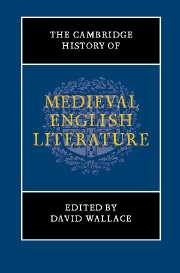Book contents
- Frontmatter
- I AFTER THE NORMAN CONQUEST
- II WRITING IN THE BRITISH ISLES
- Introduction
- 7 Writing in Wales
- 8 Writing in Ireland
- 9 Writing in Scotland, 1058–1560
- 10 Writing history in England
- 11 London texts and literate practice
- III INSTITUTIONAL PRODUCTION
- IV AFTER THE BLACK DEATH
- V BEFORE THE REFORMATION
- Chronological outline of historical events and texts in Britain, 1050–1550
- Bibliography
- Index of manuscripts
- Index
Introduction
from II - WRITING IN THE BRITISH ISLES
Published online by Cambridge University Press: 28 March 2008
- Frontmatter
- I AFTER THE NORMAN CONQUEST
- II WRITING IN THE BRITISH ISLES
- Introduction
- 7 Writing in Wales
- 8 Writing in Ireland
- 9 Writing in Scotland, 1058–1560
- 10 Writing history in England
- 11 London texts and literate practice
- III INSTITUTIONAL PRODUCTION
- IV AFTER THE BLACK DEATH
- V BEFORE THE REFORMATION
- Chronological outline of historical events and texts in Britain, 1050–1550
- Bibliography
- Index of manuscripts
- Index
Summary
This section, which employs the problematic but indispensable organizational categories of ‘Britain’ and ‘the British Isles’, begins with chapters on Wales, Ireland and Scotland. We then move to a study of historical writing in England – the mode of writing that did most to define English imaginings of, and claims to, Wales, Ireland and Scotland. We end with a study of writing in the English capital between 1375 and 1485, a period which seals a shift away from monastic domination of documentary, historical, and myth-making practices.
Wales, Scotland and Ireland have generated literary traditions, sponsoring institutions, and forms of imaginative pleasure that are peculiarly their own; the chapters dedicated to them here write their histories, so to speak, from the inside out (with the English sometimes visible, sometimes not). Developments in these countries often run against the teleological grain of traditional English historiography. For Scotland, 1058 (when Malcolm III ascended the throne) is a more important date than 1066. In Gwynedd (north Wales), territories lost after 1066 were regained in 1135; the next sixty years witnessed a great cultural revival. And in fifteenth-century Ireland, Irish was winning the battle to become the pre-eminent vernacular (as Norman French faded away and English struggled to hold on). Each of these countries elaborated cultural and geographic conceptions that made scant reference to England. Welsh bards, effectively inventing the notion of ‘Britain’, sang of a territory that took in large areas of northern English and Scottish territory; Gaelic poets in Scotland and Ireland shared links through the Gaidhealtachd that persisted long after the Middle Ages. All three nations absorbed cultural influences through contacts with Anglo-Normans (or Cambro-Normans, Hiberno-Normans and Norman Scots); but all three also enjoyed direct and fruitful dealings with the continental French.
- Type
- Chapter
- Information
- The Cambridge History of Medieval English Literature , pp. 177 - 181Publisher: Cambridge University PressPrint publication year: 1999

